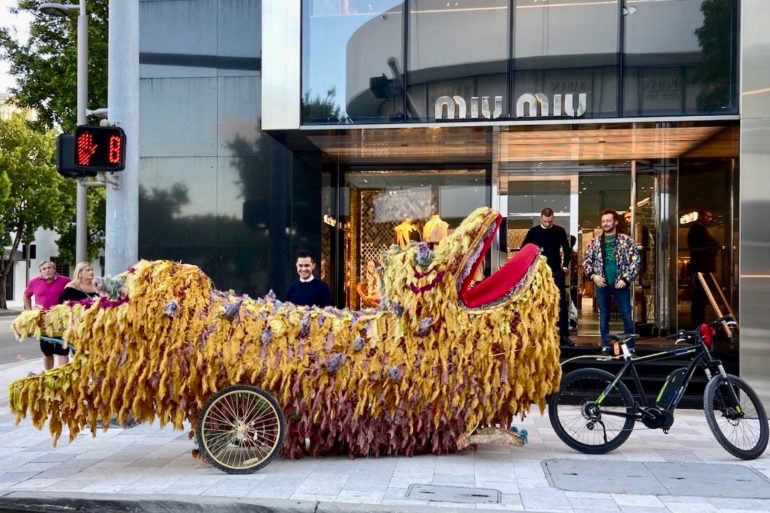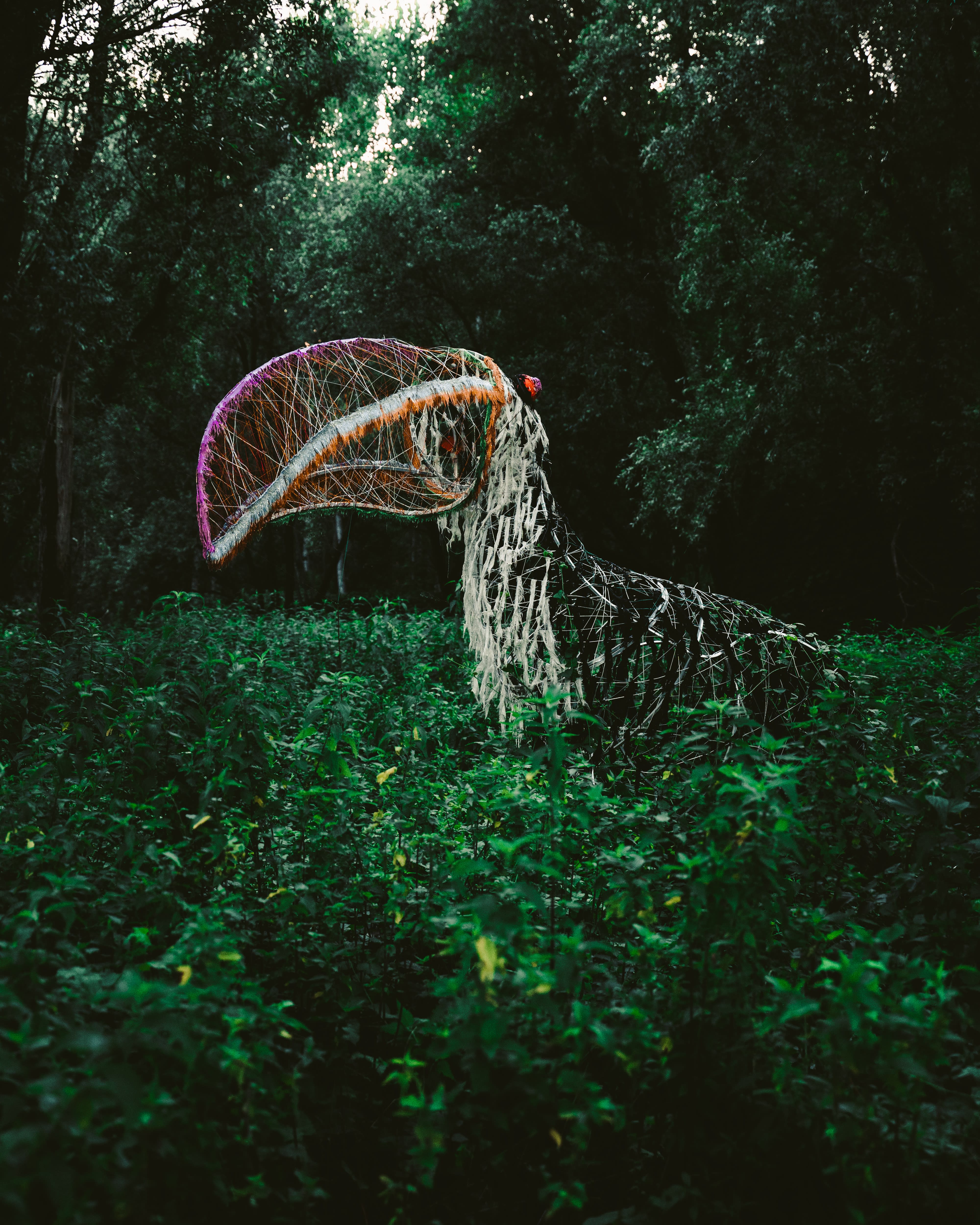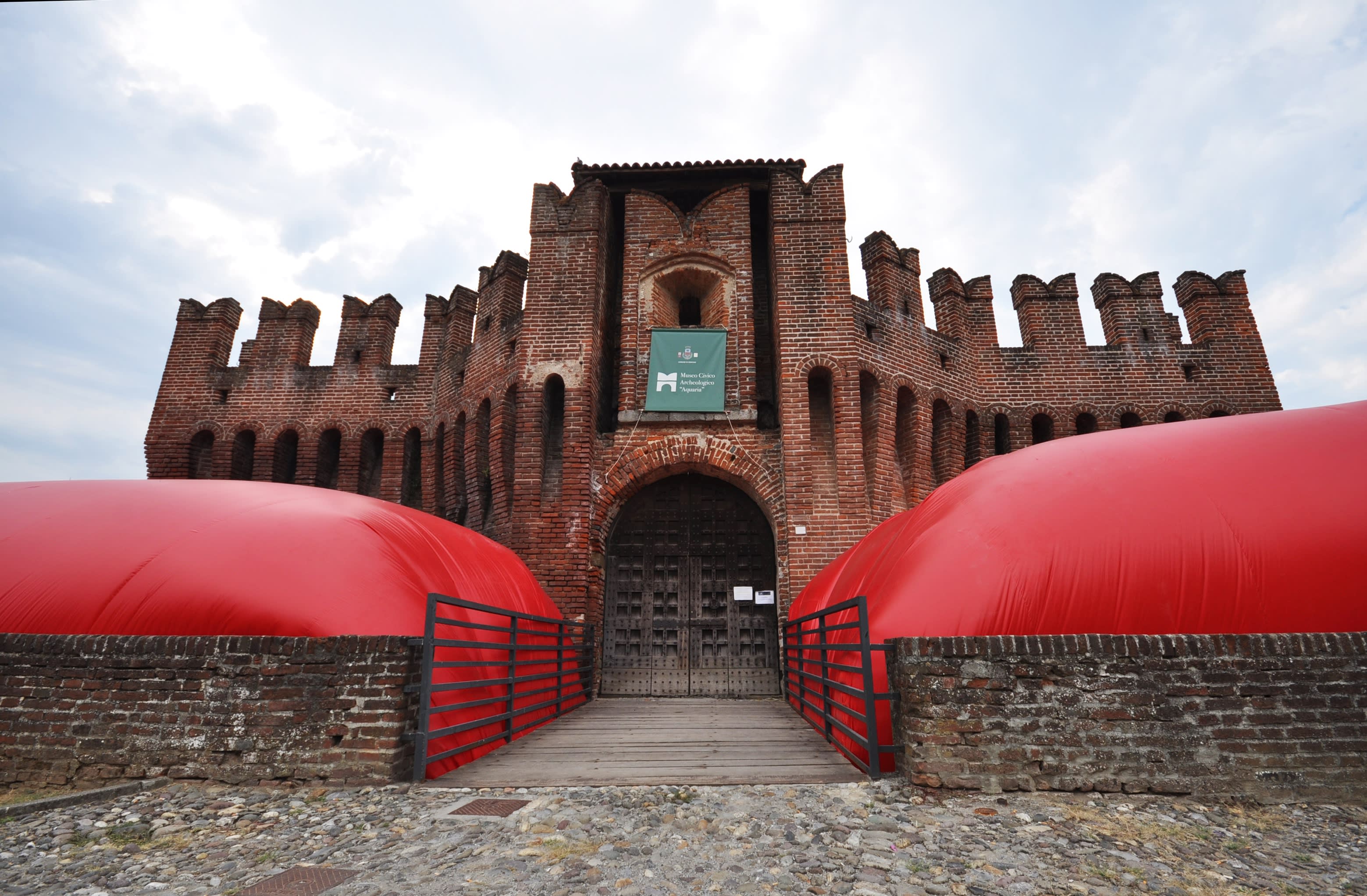This is the first CAMP Conversation I’m having with someone whose process I’ve bared witness to. It’s also the first CAMP Conversation where part of it took place while the subject of the interview was halfway through a ten-mile bike ride.
The latter statement isn’t all that surprising. In November of last year, Stefano Ogliari Badessi took over our gallery space to construct a larger-than-life, mobile two-headed “monster” titled I Don’t Know Where to Go from scratch for a larger exhibition, A Tribe from Wonderland, which featured a composite of his works from the last few years. The flashes and bangs of his welding at the gallery entrance are forever burned into my memory, and there are still pieces of the silk scraps embedded in my suede Creepers. I Don’t Know Where to Go was a reflection of our fears and identities, made from rebar, repurposed construction netting, and silk scraps from Mantero 1902, which Ogliari Badessi biked around Miami during 2019’s Art Week festivities.
True to his nomadic zeal, Italian artist Stefano Ogliari Badessi sculpts pieces with the same ephemerality of passing observations and dreams, the kind that are so absurd and vivid that we keep the memory for life. His pieces are consciously composed of found materials and forged from an enduring quest to tease apart the complexities of existence without the pretense of philosophical thought we’re used to. Ogliari Badessi takes the melodrama and anguish of reflection and repurposes it much like he does with his multimedia installations, creating experiences meant to connect us to our core selves—and then he packs it up and leaves without a trace (save for the silk on my platforms).
Ogliari Badessi’s approach to sculpture and installation is one guided by mindfulness and a reverence for ancient and indigenous traditions with adoration for the natural world. Thus, the quirky and dreamy experiences he sculpts are not only mirrors for what’s happening in his own mind, but they reflect our desire for the joy and freedom of untapped, subconscious worlds and meaningful connections with the worlds we already exist in.
If there’s anything to learn from Ogliari Badessi, it’s that self-awareness and self-discovery are essential, and neither have to be an experience that is suffocating or unsettling—it can be fun, freeing, and responsible.
Can you pinpoint the moment where you felt you became a “nomadic installation artist”? Have these qualities always existed in you, or did you have to put in the work to grow this way?
When I started to love the idea of traveling by sculpture—it sounds like something extremely obvious, that someone likes to travel, but if you like to do sculpture, it’s not so obvious because it takes space. I had to destroy the idea I had of sculpture and art. I started making sculptures inflatable or very small so they can fit in my suitcase, or sculptures on wheels so I can move them around on bicycle.
I don’t think this already existed in my artwork. It started when I lived in Shanghai in 2014. I lived in China for two years and at the beginning, I started to change my sculpture. I don’t think I had this concept in my sense, and then I pushed more and more, because it’s a good way to enjoy and propose art in different ways.
What attracts you to your color palette?
Bright and vivid colors because art, for me, is linked with joy and experience. If I’m sad, I don’t do art that day. I don’t use sad colors.
What about material? How does a material’s or location’s energy influence your work?
Materials depend on where I am. In Shanghai, I used plastic; in Crema, wood. It’s about mobility and moving in a natural direction. I just stay open-minded, though sometimes I change my mind.
You are meticulous in the best way about every facet of a piece, including where it’s going to go and how every detail must work in tandem to create these uniquely multi-sensory experiences for people. You’re open-minded but you still know exactly what you need, and how things must work together. Can you talk to me about your process when you’re putting pieces and installations together?
Sometimes it seems like a random process, but it isn’t, I just keep my attention open. It can take me five minutes—investing time to discover something else, and maybe the same with material. It may take some time. In school I learned about the importance of material and recycling, giving materials a second life. In the same way in art, sculpture, if you look at materials in a different way, you can find something to work with, for sure. Everything is a bank of material.
Is there a larger theme across your body of work?
No, there isn’t one big theme because I change subjects, I change materials, and I change visual results, and a lot of things. I change [source of] inspiration—in Shanghai it was different from when I was in Mexico, and this panorama of mine has changed now that I’m living in Italy. The things around me and my experiences change. It’s difficult to keep my art the same as before. Artists, they love one clear, recognizable subject, or like, visual appeal and I don’t. In five or six years, I changed a lot about myself and it would be crazy if I were doing the same thing as I was ten, fifteen years ago.
How far in advance do you plan exhibitions and installations?
Sometimes a year in advance. I like this approach so I can go as big as possible. Sometimes I plan for an event or exhibition a month in advance. A sculpture can be born in three days or six months. If you’re playing around with technique, you can get lost in it.
What, for you, is the appeal of experiencing a dream world in waking life?
I see dreams as extra potential of our brain. We use, like, 20% of our brains, for sure not the total amount. Dreams are an extra little piece to use. The key of dreams opens a lot of doors. There is the dream side, and the invisible side, and the side you don’t know about. There is real life, and you pay attention to what’s really around you. There are dreams, another world when your eyes are closed. But, then there’s an invisible world around you that you don’t even see. Energy, probably, or god or the universe, or magic. We like to think that as humans we understand everything, but we don’t.

Stefano and “I Don’t Know Where to Go”, parked outside of the Miu Miu storefront in Miami’s Design District. 2019.[/caption]
Although you create fantasy beings and worlds, there exists a connection between the imaginary nature you’re working with and that in our real lives. Is this purposeful? What it is that you wish for people to understand through interacting with your work?
I think I was more abstract in some way before, but now they’re taking a different aspect. Nature is also taking different aspects. It’s taking on faces, eyes, mouths. It’s like reverse logic. Our connection with nature is deeper, and we as humans like to give life to nature, like a tree with eyes, to make our connections easier. The tree is alive anyway, and can see without eyes like ours, but in our minds. In this process, giving eyes and everything to nature, just deepens the connection that is already there. In some way it’s a normal process, like ancient symbology. Apollo was the god of the Sun, but I mean, it’s the Sun—it’s a star, it doesn’t have a physical body. It’s just symbolic.
If people understand that, I think yes. They understand the monster [I Don’t Know Where to Go] through connecting to their fear, animals with animal nature. When they’re in front of sculpture, they have a better connection with unconscious, obvious concepts and symbols that we don’t know too well.
I know that energies are important to you, especially those you find within natural environments.
It’s an ongoing process. I need a lot of practice, and sometimes I’m not so good at practice. I believe in elements and energy—stones, trees, crystals. I‘d say that, probably, the first step is not thinking that everything is already done and static. When you think that you don’t know anything, you can stay open to everything and connect better. Ancient traditions have done this very well and know this pretty well, but that’s been forgotten. It’s beautiful to stay open.
How do you maintain that relationship between yourself and the environment when we’re very much surrounded by unnatural environments nowadays?
Art, for sure, is a way to practice. It’s not the goal—it’s a tool. It’s a tool to practice connecting to the world around you in the best way, and to be able to communicate. We are not in reality—we’re not fighting to save the Earth, we’re fighting to save ourselves, because the Earth will save itself. In some way, I think what we can do is try to be the best guardians of this, because we’ll all disappear and I think Earth will be okay.

Tucano, Stefano Ogliari Badessi. Photo credit: Andrea Zanenga[/caption]
Your work doesn’t necessarily stay in one place either, with pieces always taking on lives of their own once an installation is finished or away from you or, to take it a step further, being integrated with landscapes that are impermanent themselves, like a Swiss glacier. How do you view fulfillment in this context? Do you think you would find similar fulfillment in creating static pieces?
I was extremely satisfied [with Nothing is Forever]. It was a bit shorter than I initially thought. People in the art world like to buy objects made of marble or bronze, because they’re thinking about time, that it’ll last forever. But that depends on how long “forever” is. Is forever a lifetime? Earth’s lifetime? The object is not forever, and the collector is not forever, either. I was very happy that it disappeared and left no trace. Leaving no trace is good. Burning Man is like that, no? They burn it all down and maybe what you saw was the best you’d ever seen in your life, and the best experience of your life. You can enjoy things for a while, and if it makes you happy for the rest of your life, that’s fine.
I had the privilege of witnessing your creative process and the construction of last year’s “A Tribe from Wonderland” exhibition during Miami Art Week. I’ve even seen you foraging for materials and adapting on the fly myself; I always come back to the time you dove into the donation dumpster across from our gallery space, which couldn’t have happened if the people who own it hadn’t been away. Have you ever come across any bureaucratic obstacles? Do you have a favorite and/or least favorite bureaucratic obstacle?
Sometimes I go ahead until they tell me no. Sometimes I do it anyway and take a ticket, and sometimes I do and they tell me to take it down. Permits are very boring—laws are not made for art. Art doesn’t combine with bureaucracy. Very often, they make problems for nothing, or because they don’t want to work more, or to save their own ass.
When I took the monster around [Crema] by bicycle, they told me the sculpture had to stay in the gallery, or in the museum. I told them “you do your job as police, and I’ll do mine as an artist. If you want to give me a ticket, give me a ticket.” Sometimes it’s about jerks, sometimes about politics, sometimes it’s about people who have their own problems. [laughs] In a conceptual, artistic way, laws sometimes have to be broken. In the worst case, people are opening their minds for five minutes. That’s my law.

An image from Nothing is Forever. Sponsored by Swatch for the Extreme Freeride World Tour. Mont Fort, 2015.[/caption]
There is an aspect of sustainability that is inextricable from your work, as in: every little thing—fabric, metal, wood, tiny object—you use has been sourced responsibly or is being repurposed.
[The materials] are not pure, nothing is pure. I don’t save the world, less with my sculptures, but if I think different, and eventually someone who sees it starts to think a little differently, it’s already a big step.
Can you talk to me about your relationship with sustainability?
My life. I do permaculture, and it’s a big system that needs consciousness and extension of energy. It’s about asking myself “who made this?”, “where is this from?”, “what’s their life like?” It’s not paranoia, it’s being careful. I study some ancient traditions, like shamanism, and the basis of that is to respect Mother Earth, first, and become even a guardian or warrior of the Earth, eventually. I consider rational things, how plants grow, what they need. I also think about the “invisible side of things.”
How does this translate to your art?
With permaculture, you’re always trying to recycle material and energy, thinking about where energy, energy like gasoline, is coming from. I’m already doing permaculture by thinking about that. If I pull a sculpture by bicycle, I’m thinking about which energy and how much energy I’m using to move a sculpture. It’s not always perfect, because I do have to take flights sometimes. In a shamanistic way, it’s about the concept behind the sculpture.
What are your feelings about the art industry’s relationship with sustainability?
I love it.
Do you think there is one?
No. No, there’s no relationship with sustainability. When I see installations with ten thousand bottles on the beach and they say it’s about recycling—and it’s not because they’re all the same, and perfect and clean—something’s wrong. But, people like and love it. One big aspect of art is communication, so in reality, they have all the power in their hands, galleries and museums.
Do you think that there are steps we can take as a collective to connect more deeply with the natural world, or have we gone too far into the waters of post-modernity?
There is a way, why not? Little steps, little things, like planting trees and in the worst case you just have trees for the next generation. Maybe calculating the carbon footprint of a fair, like Art Basel calculating their carbon footprint or donating 1%, which is nothing, to the city. In this way, art could become something more permanent. The impact is more permanent, not just giving a good party and things like that.
How does it make you feel when you hear about the environmental repercussions of projects like Christo and Jeanne-Claude’s “Surrounded Islands”?
They have a different understanding. I love Christo, but they weren’t thinking about the environment. Maybe at that time, nobody was thinking and speaking about environmental issues like now. So, I love it. The installation was one of my favorites. The later one was probably more conscious.
My last questions are like a baby lightning round—very short and fast. What is most important to you as an artist?
Creativity is the major one, I think.
What is one of your dream projects?
The one I’m working on for the Guggenheim—a structure floating on water.

RED Emotion installation at the 56th Venice Biennale, 2015.[/caption]
Do you have a favorite piece or exhibition?
Nothing is Forever on the Swiss glacier with Swatch. Also, the balloon [RED Emotion] at the Venice biennale.
Are there any materials that you want to work with but haven’t had the chance?
Glass, like blowing glass. It takes years. Another is water, as a material.
Are there any other styles or movements that you connect with outside of the one you work within?
Definitely Futurism, and I like Dadaism.
